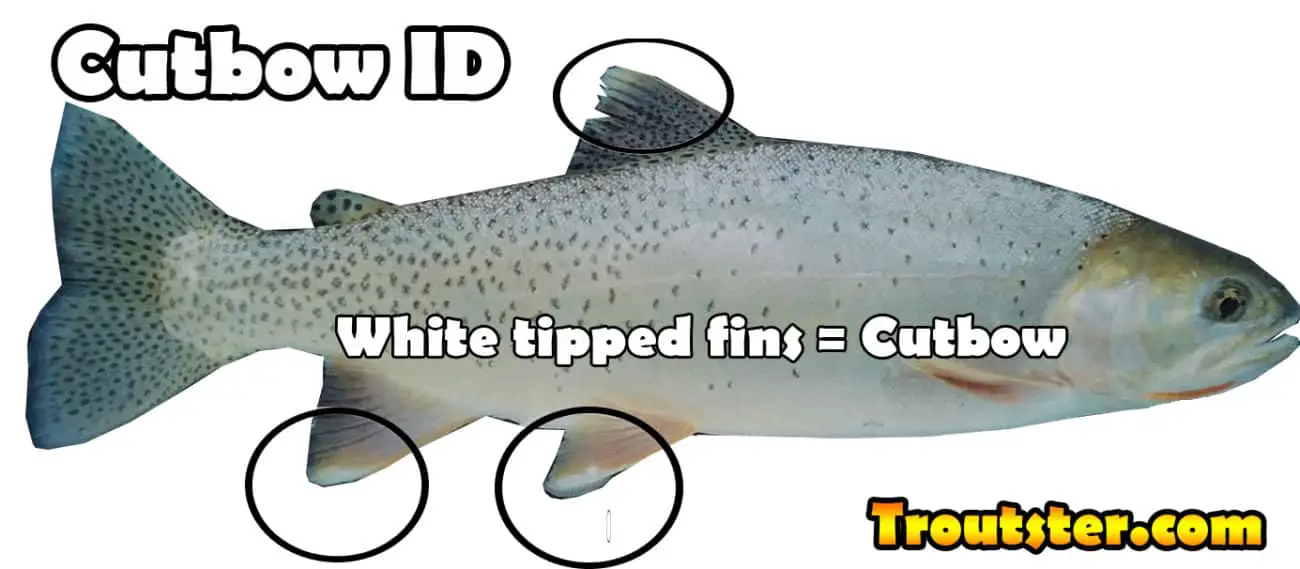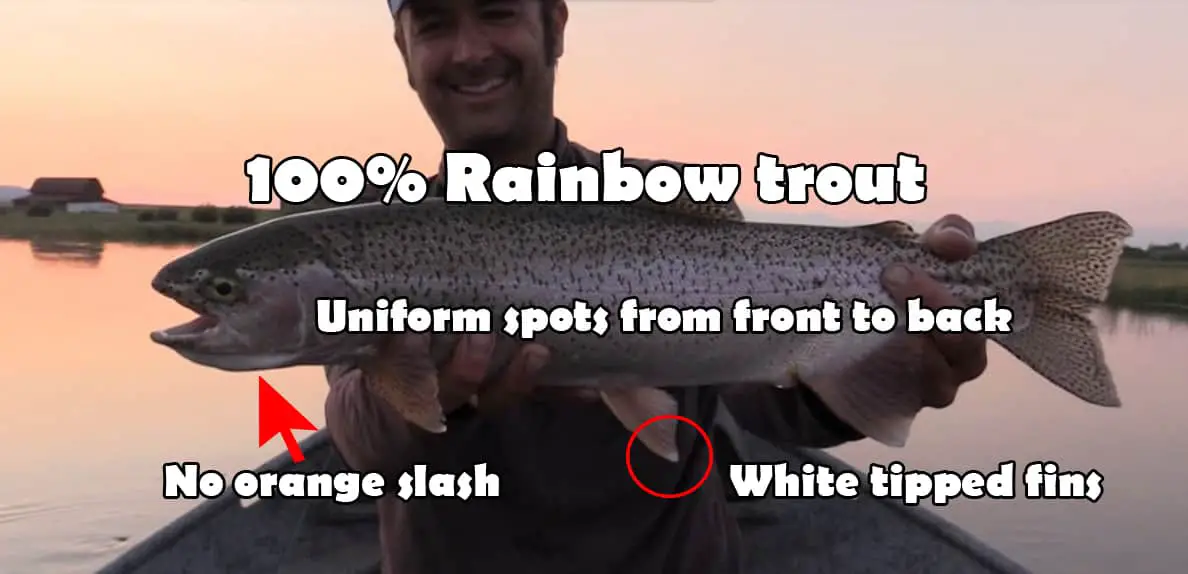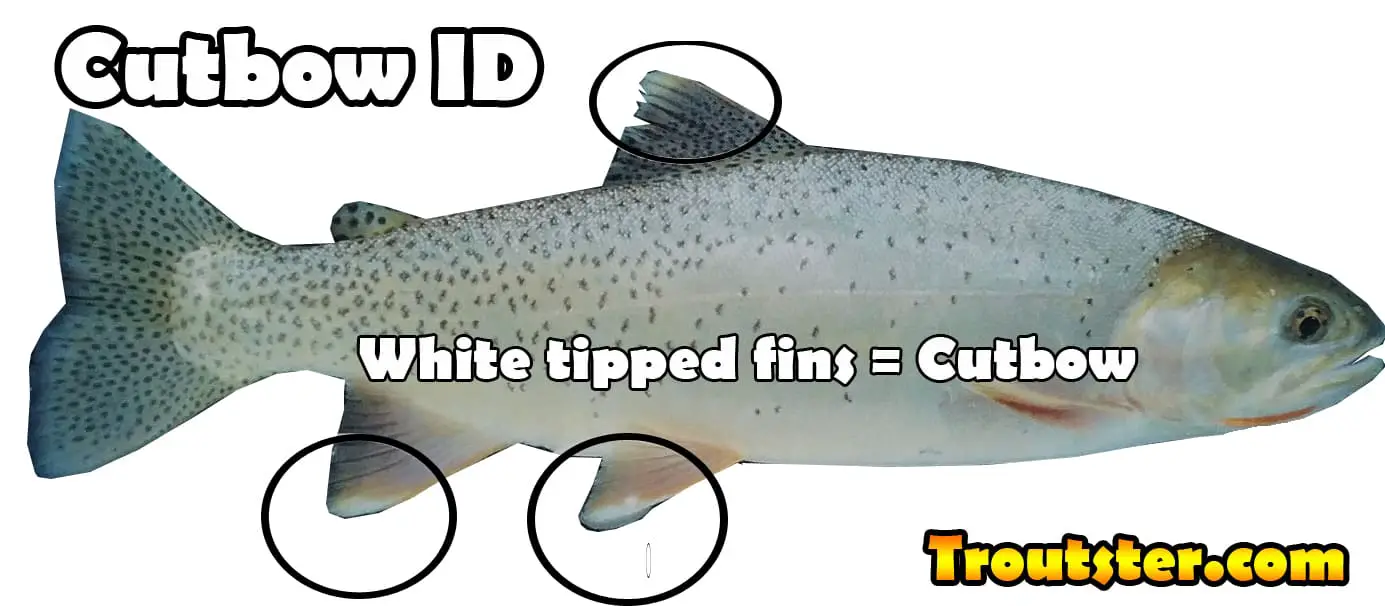This post was last updated on December 3rd, 2022 at 07:07 pm
I’ve had several requests in the past to explain how to tell the difference between a rainbow, cutthroat and cutbow trout. Learning to differentiate a cutbow trout from a pure cutthroat is very important.
In many areas, it’s actually illegal to kill any cutthroat trout, but it’s often recommended that you do kill hybrids (cutbows) and rainbows. The Idaho fish and game department actually pays a sort of bounty for rainbows and cutbows in the Snake river.
In this article, I will teach you how to quickly tell whether you’re looking at a cutbow, vs any other trout species or hybrid.
Tips for Cutbow Trout Identification

Difference Between Rainbow, Cutthroat, and Cutbow Trout
Perhaps the fastest way to ID a cutbow trout vs cutthroat is by looking at the fins. If there are white tipped fins, you’ve caught a cutbow. This method is usually spot on, but there are other ways to tell a cutbow by looking at it.
Look at the spot pattern on most full fledged cutthroat. You’ll see that the spots on cutthroat are more dense towards the tail and become quite sparse towards the front end of the fish. The cutbow in the image above has the spot pattern of a cutthroat.
Rainbow trout have more uniform spots throughout the fish. The spots toward the rear of the fish are just as dense as they are near the head.

In the image above, you can see the full rainbow trout has some very unique traits. It is lacking the orange slash by the gills. It has a chrome color and of course the uniform spots from front to back. The first sign that this trout was a rainbow trout or hybrid was its jumping spree moments after hooked. (See that video here) The rainbow trout will almost always fight harder than a cutthroat.
By studying the traits of a rainbow trout, you’ll be able to more easily identify cutbows. You’ll almost always see rainbow trout characteristics in the spots and/or coloration of cutbow trout.
Cutthroat trout are classified as Oncorhynchus clarki and, while they are also native to the western United States, their range only extends east to the Rocky Mountains where they have evolved through geographic isolation into 14 distinct subspecies; each of which is native only to its originating major drainage basin.
Additionally, their colors can range from golden to gray in the back and, depending on subspecies, strain and habitat. Most have distinctive red or pink marks on the underside of their lower jaw and in lower folds of gill plates responsible for them being given the name “Cut throat” by outdoor writer Charles Hallock in an article published in The American.
Hopefully this will answer any questions you might have had about cutbow trout identification. Let me know if you need more assistance with a comment below. Thanks for stopping by!
Cutbow Trout FAQ
Can you fly fish for Cutbow trout?
Yes, you can go fly fishing for cutbow trout. In fact, these fish will act exactly like rainbow trout when it comes to taking a fly. One of the most effective tactics to catch them is to use nymphs or dry flies, depending upon the weather conditions.
Here’s the best article I’ve found on how to fly fish for rainbow trout.
How do you identify a Cutbow Trout?
One of the fastest ways to ID a cutbow vs cutthroat trout is by looking at the fins. If there are white tipped fins, you’ve likely caught a cutbow. Rainbow trout are also known for white tipped fins, so it also helps to observe the orange slash on the head or below the gills of the cutbow trout.
Can a cutbow trout reproduce?
Yes, they typically spawn during the spring in colder waters around 40-50 dgerees, during which time they create redds in gravel and lay hundreds of eggs, which hatch a few weeks later.
Can you eat cutbow trout?
Yes, cutbow are a meaty fish and can be cooked in many ways, similar to other trout species. The meat has an identical taste to that of rainbow trout, and full-blooded cutthroat trout.

